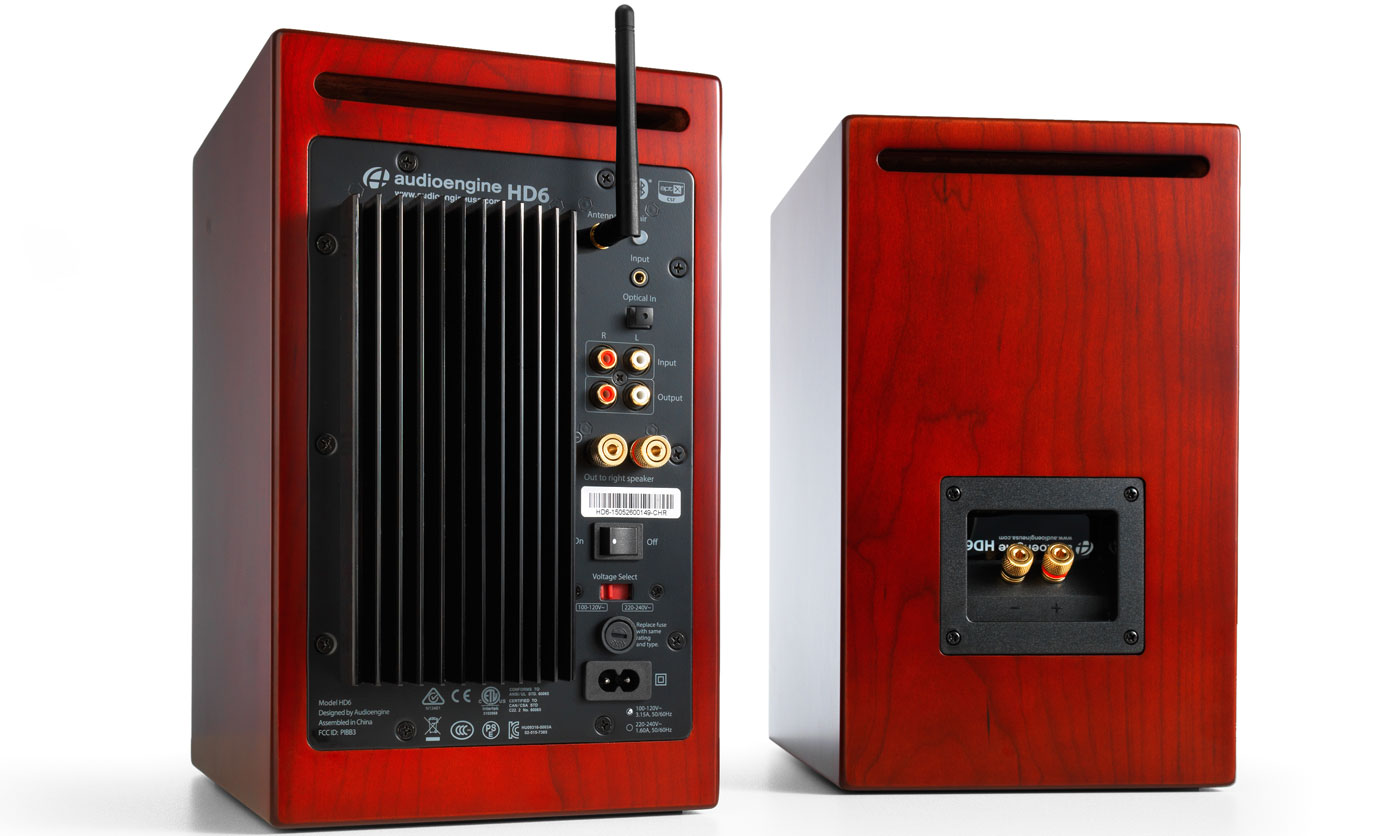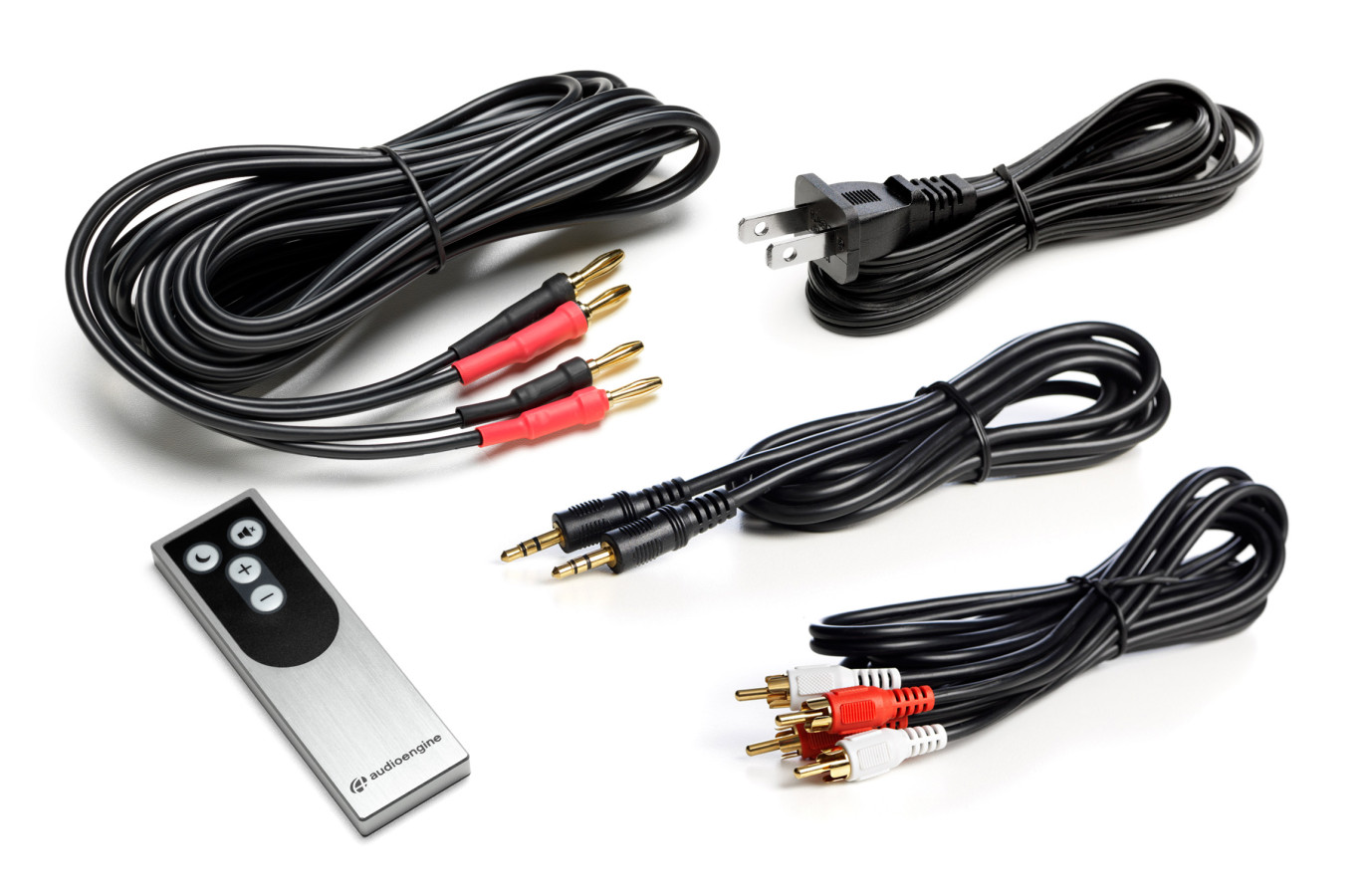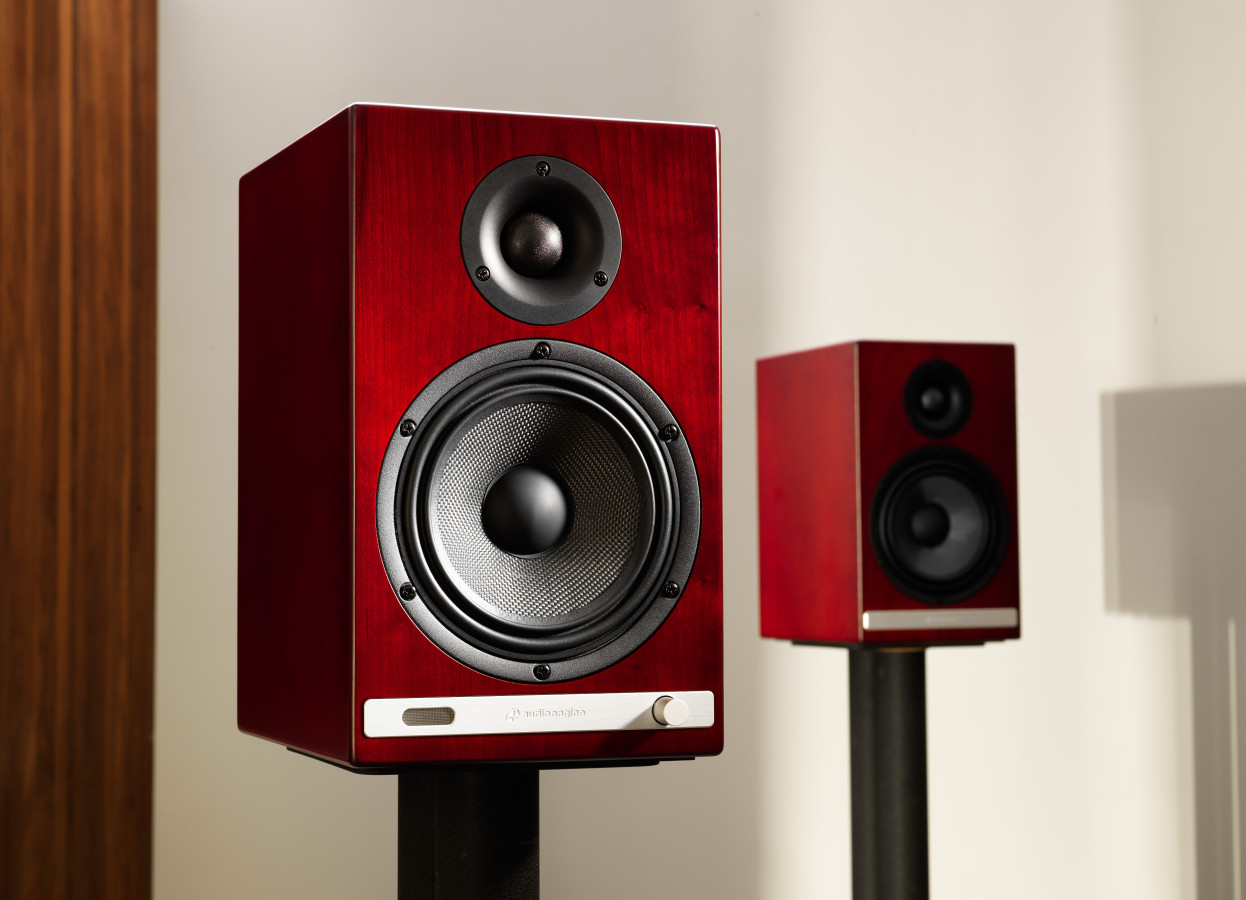Description
I’ve had a pair of Audioengine A2 powered speakers since 2008. They’ve been with me during vacations, they played music off my iMac, and I’ve always loved them. I’ve recommended the company’s bigger A5+ to friends because of how great they always sounded at Audio Shows and how much I love the little A2. So, it was with great anticipation I unboxed their new top of the line HD6 speakers.
When you unpack the new HD6 speakers, it’s obvious that these are Audioengine’s flagship powered speakers. The box was larger and heavier than I expected. Everything about the packaging for these speakers says high-end. Not only do the speakers come in nice microfiber bags, but so do all the accessories. I mean each accessory has its own little bag. I got the idea unpacking these that Audioengine was proud of these speakers, as well they should be.
When I replaced the beautiful little Audience 1+1 speakers with the Audioengine HD6, my 30-year-old daughter-in-law said, “man those are beautiful.” I agreed; the HD6’s are some of the best looking small speakers ever. One of the things I liked was the way they looked like real wood instead of the super high gloss most speakers are today. The finish reminded me of a pair of Rogers from the 80s, which even then cost more than these and weren’t powered. The review sample was in a luxurious cherry, but you have a choice of satin black, cherry or walnut. Like my $2,400 Audience speakers, the HD6 had really nice magnetically attached grilles that just add to the HD6 the look, fit, and finish of a far more expensive speaker.
The HD6 drivers consist of a 5.5-inch Kevlar woofer and a very nice one-inch silk dome tweeter. The left speaker houses the power amplifiers for the left and right speakers, with all the inputs listed in the specifications as well as a pair of stereo RCA output jacks you can use to run a powered subwoofer. The 75-watt per channel amp isn’t Class D but a very nice Class AB power amp. Also inside of that left speaker is a 24-bit/192 kHz DAC. On the back, there is a small antenna for the on-board aptX Bluetooth receiver. This allows you to stream music from your phone or other devices. There is also one more thing on that left speaker, namely a small volume control knob on the front baffle. The speakers also come with a simple solid metal remote control with volume, mute, and standby buttons.
Listening
To start with, I simply set the HD6s where my Audience 1+1s had been sitting. Of course I didn’t use the Electrocompaniet integrated amp and at first, I didn’t even hook up the subwoofer. I ran the very nice speaker cable that came with it from the left speaker to the right speaker. I hooked up the Oppo BDP-105D Bly-ray player and the audio from the rest of the video system to that magical left speaker. It took about five minutes.
I was so excited about these speakers as I unpacked them and saw how they looked, that I made what may seem an odd decision: I would compare them to the sound of my Audience 1+1 V2+ speakers driven by my Electrocompaniet PI 2D Prelude Integrated Amplifier without hooking up the pair of TBI Audio Systems Magellan VIP su Active Subwoofers. Not counting cables, this means I was comparing a pair of $749 powered speakers and DAC to $8,900 worth of speakers and amplification. I know this was crazy, but my hopes were high.
I first used them playing a TV show, and my hopes crashed. The sound was muffled, the bass was boomy, and the top-end was splashy. My son commented they didn’t sound very good and that evening, while watching a docudrama, my wife commented that the sound seemed muffled. I could have given up and just taken them upstairs and reviewed them as a pair of computer speakers. I didn’t though because I realized there was both a pair of speakers, an amplifier and a DAC that needed to break in. They didn’t sound a lot better the next day, but by the time they had a hundred hours on them, I’m glad to tell you it was a very different story.
In some way the broken-in sound reminded me of the B&W 805S speakers I reviewed — maybe it’s just the way Kevlar drivers sounded after breaking in. They sounded better at 100 hours, but they didn’t sound their best until about 200 hours. I suggest setting them up and playing them hard for about 200 hours, and you will be well rewarded. As they were breaking in they moved from slightly muffled sounding, to slightly veiled and finally, opened up.
Let me get the shortcomings of the Audioengine HD6 out of the way so I can end the review with all their positives. I should preface this by reminding you that they replaced a system that retails for $8,900 and that the Audience 1+1 V2 is some of the most transparent speakers on this planet. Compared to this system, the HD6 never developed quite the same degree of transparency or articulation. They also weren’t the last word in PRaT (pace, rhythm, and timing), but they were more than respectable in this area.
The only problem of the Audioengine that’s not a sin of omission is they were a little thick sounding in the upper bass/lower midrange area. This is a fairly narrow range and not noticeable a lot of the time. Placing the speakers on stands and moving them out into the room really minimizes this problem.
Now getting on to the things these speakers did so well. After break in, I was shocked how big these speakers sounded. I mean they had real scale. It didn’t matter whether I was listening to a big band, a symphony orchestra or watching an action movie, they sounded huge. The soundstage was very wide, very deep and they had a great vertical soundstage. Add to this scale a sense of real power and you have a really impressive sounding system.
The Audioengine HD6 played voices very naturally with a really nice sense of air around them. There was also nice air around instruments. The balance of the midrange on the HD6 reminded me a lot of some of the excellent British monitors; especially the balance of the midrange to the upper bass. The Audioengine speakers never sounded bright or over detailed, but I hardly ever thought they lacked in detail. They provided a very satisfying sound for music and videos. No, they didn’t have the sparkle of my Audience speakers, but again I’m comparing them to a system that cost more than ten times what they cost.
Now, let’s talk about the bass. While I mentioned the small problem with the upper bass/lower midrange area, overall the bass on the HD6 was amazing for a speaker at this price point. This was especially true considering the amps and DACs are built into the speakers. Come to think of it, maybe this has something to do with why it’s so good. I’ve never had much experience with active loudspeakers except for subwoofers and smaller desktop speakers.
Anyway, the bass sounded much deeper than the 50Hz quoted in the specifications. I think it’s because of the scale and power this little package delivered. Anyway, I found the bass very satisfying and involving without hooking up my subwoofer, even when watching movies.
Comparisons
I have reviewed two speakers that would be worth comparing the Audioengine HD6 to. First, are the Serene Audio Talisman active desktop speakers. The Talisman cost $300 less; they included a phono preamp, but not a DAC. I think these two speakers are for very different applications. The Serene was pretty well limited to being used as a desktop speaker, but if that’s what you’re looking for it’s hard to beat. Simply plug an iPhone or similar device into it and you have wonderful music with lots of snappy micro-dynamics and real Pace, Rhythm and Timing. The sound was lively and it was lots of fun. With vocals, these little speakers distinguished themselves above other desktop speakers I have heard.
If you want a more full range speaker that can also play loud enough to fill a room with sound, then the Talismans aren’t for you. The HD6 can do this, though. They ware much more powerful, they produce a much louder sound and have deeper, more powerful bass. So, the second speaker I want to compare them to is the Vanatoo Powered Speakers I reviewed in the summer of 2014. Just looking at the two speakers one would think the Vanatoo speakers with their addition of a passive woofer might outperform the HD6. They don’t, though. The HD6 were better in every way. I think this may be because of the quality of AB class amp verse the class D amp in the Vanatoo. The HD6 simply sounded more alive, had a nicer top end and were less boxy sounding.
Conclusion
I think for many people the Audioengine HD6 is just what the doctor ordered for putting together a dorm, bedroom or office system. They are very user-friendly; they look great, and they are a complete audio system for digital and with the addition of a turntable with a built-in phono preamp, they can even meet the vinyl lovers’ needs. I cannot overstate how impressed I am with this little audio system that disguises itself as just speakers. Highly Recommended!
Copy editor: Laurence A. Borden
- (Page 1 of 1)




Thanks for the thoughtful reviews. I really like your review on the Talisman speakers and your comparison with the HD6. I was wondering what you thought of the Talisman plus a subwoofer compared to the HD6 (especially considering you could get a pretty decent sub with the $300 you’d be saving going with the Talisman). Thanks again!
I have these powered HD6 speakers from Audioengine. I agree with the review’s take on what these speakers offer. They are never too bright, no matter what music I play or how loudly I listen. I listened to some tracks tonight that would have been too bright with many other speakers, and it was a joy to hear the higher frequencies played loudly without any harshness or fatigue. And yet they are detailed, as I can hear singers breathing and so on. The best characteristic, though, is the natural tonality. Birds sound like birds, vocals sound pure in music, acoustic guitars are glorious, and dialogue is spot on with TV shows and news programs.
I have mine on top of short IsoAcoustics stands, which are on top of heavy metal stands. I was amazed to hear a huge difference when I added the IsoAcoustics stands. The midrange became much fuller and pleasing with this inexpensive addition. Without the IsoAcoustics stands, the sound was much thinner.
I added two 12 inch subwoofers. I am running the HD6 speakers full range and just use the subs to fill in the low bass.
The feature set, with analog in from your own external DAC, and digital in to its internal DAC, means that you can play music or listen to the TV without having to use an extra remote or the one supplied. I love the convenience!
My set up could not be simpler for music: iMac > external DAC > speakers > subwoofers. For TV: TV > $60 analog to digital converter > speakers > subwoofers. I only use one remote control for TV, the one that came with my cable TV service. No remote needed for music. I am not using a preamp or receiver, as they are not needed.
I highly recommend the HD6 speakers. They are one of the best bargains in audio, they are very versatile, and they can sound very good if set up right.
Proper placement & break – in mandatory….give them 3-6 months…to prove themselves…..